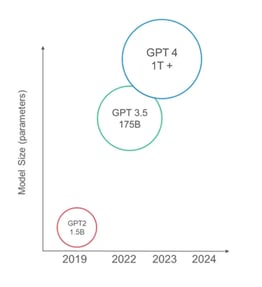In a short period of time, artificial intelligence (AI) large language models (LLMs) like ChatGTP and Claude have made leaps and bounds in terms of their size and sophistication. Size, as measured by the number of parameters, has increased by a factor of one thousand in merely five years, and it’s not projected to stop (Figure 1). This rapid growth raises numerous questions about the future of AI, while also presenting immediate challenges, with power consumption being a significant concern.

Figure 1: Model size over time for ChatGTP, a well-known large language model
Building and using these growing models consumes more energy than it did in 2019. Training requires vast computational resources to process data, response generation consumes a significant amount of power when there are many users on a platform and storing and accessing models requires high-functioning data centers. EPRI’s 2024 report, Powering Intelligence: Analyzing Artificial Intelligence and Data Center Energy Consumption, highlights that a ChatGTP request requires about ten times the electricity of a traditional Google query (i.e., 2.9 watt-hours versus 0.3 watt-hours). As more and more people and products leverage this technology, it’ll consume more of the global electricity demand.
High power consumption places greater demands on the power electronics in data center infrastructure. Efficiency is paramount, and significant improvements can be achieved through the use of low-loss, high-density power converters.
Implementing Low-Loss, High-High Density Power Converters in Data Center Infrastructure
Implementing resonant converters to reduce switching losses is one way of increasing efficiency. Take the example of an LLC resonant converter, shown in Figure 2.
 Figure 2: Simplified LLC resonant DC/DC converter
Figure 2: Simplified LLC resonant DC/DC converter
In an LLC resonant converter, power switches generate a high-frequency square wave that enters the resonant tank. The tank elements harmonics and outputs a sine wave of the fundamental frequency. From there, a high-frequency transformer scales the voltage up or down to meet specifications, and, finally, a diode rectifier converts the sine wave into a stable DC power supply.
Controlling the switches so that the square wave frequency maintains a predictable relationship with the resonant frequency of the LLC tank maximizes efficiency, whether the square wave frequency is slightly above or below the resonant frequency. By timing pulses with the modulation of switches, adjustments can be made to avoid hard switching losses and improve efficiency.
If the switching frequency is predictably higher than the resonant frequency of the LLC tank, the converter is operating in zero voltage switching (ZVS) mode for high-efficiency voltage conversion. If the switching frequency is predictably lower, the converter operates in zero current switching (ZCS) mode, which enhances efficiency by reducing stress on the output diodes.
Depending on the application within the data center environment, resonant circuits leverage different types of capacitors. Regardless of the setting, resonant capacitors with the following characteristics support efficiency gains in data centers:
- Low ESR/High Q
- Constant capacitance
- High voltage ripple handling
As higher frequencies become more common with the use of wide bandgap semiconductors, we’re seeing a shift from film capacitors to ceramic capacitors in some application areas, data centers included. Class 1 ceramics offer stability over temperature, DC bias and low equivalent series resistance (ESR).
With expertise in high-reliability and high-performance components, Knowles Precision Devices is prepared to support the rapid infrastructure improvements needed to support AI expansion. For more information on our standard and custom offerings, see our high-power RF capacitor specs or contact us directly.

